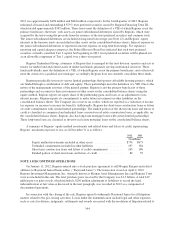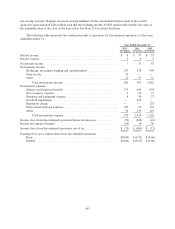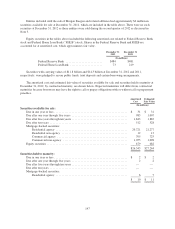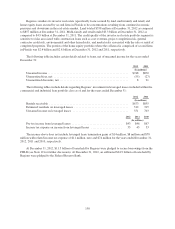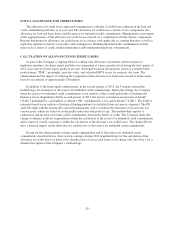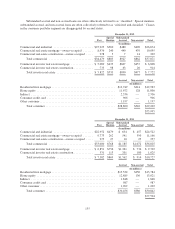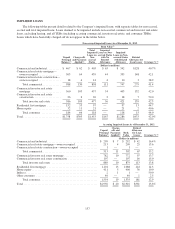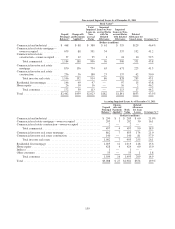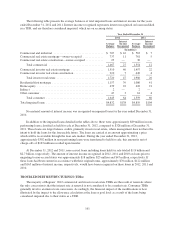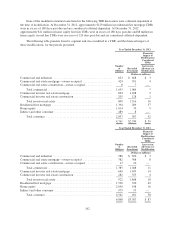Regions Bank 2012 Annual Report Download - page 170
Download and view the complete annual report
Please find page 170 of the 2012 Regions Bank annual report below. You can navigate through the pages in the report by either clicking on the pages listed below, or by using the keyword search tool below to find specific information within the annual report.purchases or other expansion projects. Commercial also includes owner-occupied commercial real estate loans to
operating businesses, which are loans for long-term financing of land and buildings, and are repaid by cash flow
generated by business operations. Owner-occupied construction loans are made to commercial businesses for the
development of land or construction of a building where the repayment is derived from revenues generated from
the business of the borrower. Collection risk in this portfolio is driven by the creditworthiness of underlying
borrowers, particularly cash flow from customers’ business operations.
Investor Real Estate—Loans for real estate development are repaid through cash flow related to the
operation, sale or refinance of the property. This portfolio segment includes extensions of credit to real estate
developers or investors where repayment is dependent on the sale of real estate or income generated from the real
estate collateral. A portion of Regions’ investor real estate portfolio segment is comprised of loans secured by
residential product types (land, single-family and condominium loans) within Regions’ markets. Additionally,
these loans are made to finance income-producing properties such as apartment buildings, office and industrial
buildings, and retail shopping centers. Loans in this portfolio segment are particularly sensitive to valuation of
real estate.
Consumer—The consumer loan portfolio segment includes residential first mortgage, home equity, indirect,
consumer credit card, and other consumer loans. Residential first mortgage loans represent loans to consumers to
finance a residence. These loans are typically financed over a 15 to 30 year term and, in most cases, are extended
to borrowers to finance their primary residence. Home equity lending includes both home equity loans and lines
of credit. This type of lending, which is secured by a first or second mortgage on the borrower’s residence,
allows customers to borrow against the equity in their home. Real estate market values as of the time the loan or
line is secured directly affect the amount of credit extended and, in addition, changes in these values impact the
depth of potential losses. Indirect lending, which is lending initiated through third-party business partners, is
largely comprised of loans made through automotive dealerships. Consumer credit card includes Regions
branded consumer credit card accounts purchased during 2011 from FIA Card Services, as well as new
originations since the purchase date. Other consumer loans include direct consumer installment loans and
overdrafts. Loans in this portfolio segment are sensitive to unemployment and other key consumer economic
measures.
CREDIT QUALITY INDICATORS
The following tables present credit quality indicators for the loan portfolio segments and classes, excluding
loans held for sale, as of December 31, 2012 and 2011. Commercial and investor real estate loan classes are
detailed by categories related to underlying credit quality and probability of default. Regions assigns these
categories at loan origination and reviews the relationship utilizing a risk-based approach on, at minimum, an
annual basis or at any time management becomes aware of information affecting the borrowers’ ability to fulfill
their obligations. Both quantitative and qualitative factors are considered in this review process. These categories
are utilized to develop the associated allowance for credit losses.
• Pass—includes obligations where the probability of default is considered low;
• Special Mention—includes obligations that have potential weakness which may, if not reversed or
corrected, weaken the credit or inadequately protect the Company’s position at some future date.
Obligations in this category may also be subject to economic or market conditions which may, in the
future, have an adverse affect on debt service ability;
• Substandard Accrual—includes obligations that exhibit a well-defined weakness which presently
jeopardizes debt repayment, even though they are currently performing. These obligations are
characterized by the distinct possibility that the Company may incur a loss in the future if these
weaknesses are not corrected;
• Non-accrual—includes obligations where management has determined that full payment of principal
and interest is in doubt.
154


